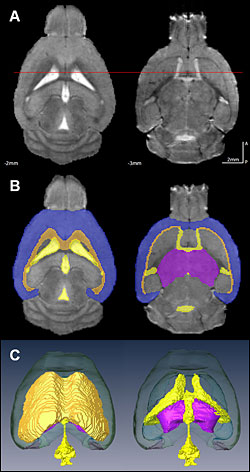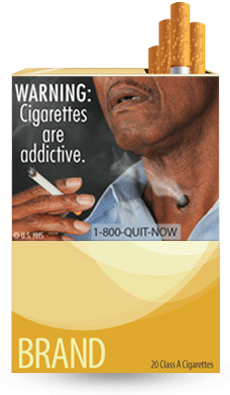Published: February 16, 2012

The scientists used MRI data mapped onto an existing atlas of the mouse brain to compare the effects of drinking ethanol and water on brain volume overall and region-by-region in mice with and without dopamine D2 receptors. Alcohol-drinking mice that lacked dopamine receptors had lower overall brain volume and reduced volume in the cerebral cortex (blue) and thalamus (purple) compared with D2 receptor-deficient mice drinking water. Alcohol-drinking mice with dopamine receptors did not show these deficits in response to drinking alcohol, suggesting that dopamine receptors may be protective against the brain atrophy associated with chronic drinking.
rain scans of two strains of mice imbibing significant quantities of alcohol reveal serious shrinkage in some brain regions — but only in mice lacking a particular type of receptor for dopamine, the brain’s “reward” chemical – but only in mice lacking a particular type of receptor for dopamine, the brain’s “reward” chemical. The study, conducted at the U.S. Department of Energy’s Brookhaven National Laboratory and published in the May 2012 issue of Alcoholism: Clinical and Experimental Research, now online, provides new evidence that these dopamine receptors, known as DRD2, may play a protective role against alcohol-induced brain damage.
[continue reading…]
 Can graphic images persuade people to make lasting changes to their behavior? The answer, according to psychological research, is probably not.
Can graphic images persuade people to make lasting changes to their behavior? The answer, according to psychological research, is probably not.
Dr. Howard Leventhal, the Board of Governors Professor of Health Psychology at Rutgers, agrees that photos are in fact stronger than words, but that images may not lead to long-term behavioral effects. Leventhal states, “You don’t need a lot of threat to get something to happen as long as the threat is associated with a clear, simple plan of action. For cigarettes, it’s more complicated, you may need a more potent level to get people to change.”
Leventhal continues, “The problem that I had with [the new Food and Drug Administration cigarette warning labels is that] it isn’t as clear to me as it might be whether there was a specific plan for action that was linked to the images. In other words, you get people motivated but if you don’t provide some concrete and specific directions for behavior, they might habituate to the threat and go ahead and do it anyway.”
These extremely graphic images, which include rotting teeth, blackened lungs, and a dead body, are intended to deter people from smoking. Paul Slovic, professor of psychology at the University of Oregon, says these warning labels may “change the aura and image about smoking for young people who haven’t yet started to smoke or are in the early stages.” But these images are unlikely to change the behavior of current smokers.
In addition, according to Carol Tavris, social psychologist and author of a recent book on cognitive dissonance, “What we know from decades of social psychological research is that fear backfires.”
Source: Association for Psychological Science
Published: February 6, 2010

© iStockphoto
Exposure to ecstasy or cocaine during adolescence increases the “reinforcing effects” that make people vulnerable to developing an addiction. This is the main conclusion of a research team from the University of Valencia (UV), which has shown for the first time how these changes persist into adulthood.
“Although MDMA and cocaine are psychoactive substances frequently used by teenagers, very few studies have been done to analyse the short and long-term consequences of joint exposure to these drugs”, José Miñarro, lead author of the study and coordinator of the Psychobiology of Drug Addiction group at the UV, tells SINC [continue reading…]
Published: January 31, 2010



